Are the roots of your fiddle leaf fig getting adequate water?
Don’t be afraid to get your hands dirty. Feel 3–4 inches into the soil. Is it damp or dry to the touch? If more than 50-75% of the soil is dry, the roots of your fiddle leaf may not be getting enough water. Let’s give your fiddle leaf a good drink. Make sure that when you water, you’re watering slowly until water flows freely from the bottom of the pot where the roots reside and into the saucer. Always empty the saucer of any standing water.
Brown spots from dryness will have dry tan or brown areas that start at the edge of the leaf and cause the leaf to curl. Your plant will overall look wilted or dry at times and the soil may have receded from the pot, causing the water to run between the pot and the soil and never reach the root mass.
Is your fiddle leaf fig near a heating or air conditioning duct?
If there is air blowing on or near the leaves, move it to a place where the air is not blowing directly on the foliage. Direct air contact will dry out your plant very quickly.
Are you able to add additional humidity to your home and your fiddle leaf fig?
Mist your fiddle leaf fig regularly until things begin to turn around, this will help increase the humidity, which your plant will appreciate. Consider adding a humidifier to your home, and don’t be afraid to give your plant a shower either outside or in the bathtub. Allow the spray to clean off the leaves and give it a good cleaning.
Are the brown spots yellow around the edges?
Brown spots on leaves that are trimmed in yellow suggest a leaf spot bacteria may be present. When a plant gets leaf spot disease, the attacking fungus or bacteria leave small brown spots trimmed in yellow where it is feeding on the leaves. These spots may vary in shape, color, and size.
As with all other fungal and bacterial diseases, better air circulation, well-drained soil, dry leaves, and less water help control leaf spot disease. You can use Liquid Copper Fungicide to treat leaf spot disease or the homemade remedy of putting a tablespoon or two of baking soda and a teaspoon or two of mineral oil in a spray bottle of water. Shake the solution well and then spray all areas of the plant that are infected.
Be sure to keep infected plants away from your other houseplants. Never mist a plant if leaf spot disease is suspected.
Trim and remove any dead or dying leaves
When removing spotted leaves from your fiddle leaf fig, never remove more than 10% of total leaves at once to avoid shocking your plant.
Lastly: We believe in you!
The more you can mimic its natural environment, the happier your fiddle leaf fig will be. Remember that these trees are native to warm, humid, tropical places where they get consistent moisture and even temperatures.











